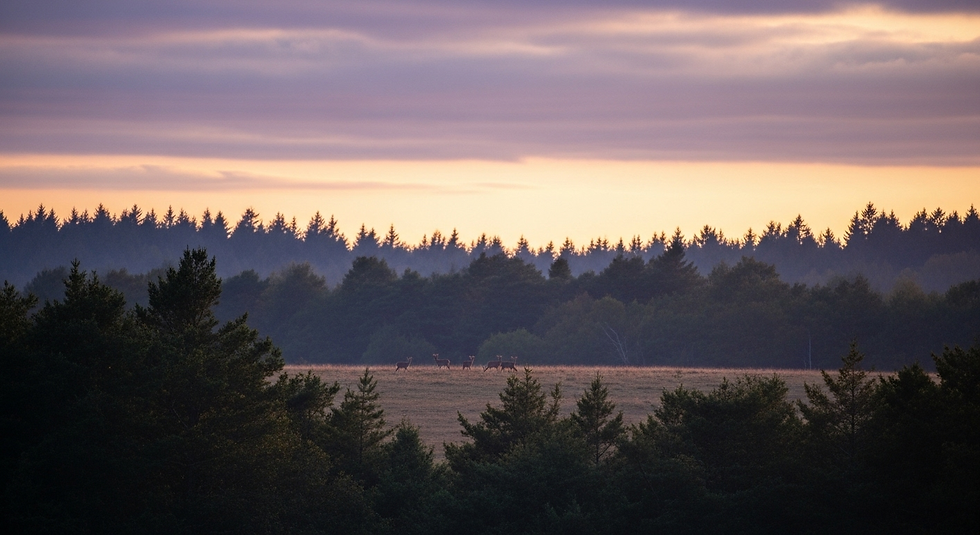How Hunters Can Help Stop Chronic Wasting Disease (CWD) in Its Tracks
- Ginger Dixon
- Jul 15
- 4 min read

Chronic Wasting Disease is Here. What Will We Do About It?
Chronic Wasting Disease. You’ve probably heard it whispered at the local feed store or mentioned at your last hunters association meeting. Maybe you’re wondering what it means for your deer, your land, and your next hunt.
As hunters, land stewards, and wildlife enthusiasts, we share a responsibility for the health of our herds. And while CWD might sound like something happening far off, the truth is it’s creeping closer in many states, and it’s time we talk about what we can do to keep our deer healthy.
Let’s break it down together. Fair warning: there are a lot of deer emojis here because I think they’re just so darn cute.
What Is Chronic Wasting Disease?
CWD is a fatal disease affecting deer, elk, and moose. It’s caused by prions: misfolded proteins that build up in an animal’s brain and nervous system. Unlike viruses or bacteria, prions don’t just go away. They linger in soil, plants, and water for years, waiting for the next animal to come along.
🦌 What does CWD do to deer?

Rapid weight loss (the “wasting” effect)
Drooping ears and a vacant stare
Excessive drooling or salivation
Stumbling or confusion
The disease progresses slowly, and deer may appear healthy for up to 18 months after infection. But once symptoms show, CWD is always fatal.
Why Hunters Should Care
Hunters rely on healthy deer populations for food, tradition, and the future of the hunt. CWD threatens all of that.
It spreads through saliva, urine, feces, and even the carcasses of infected animals. That means a single infected deer can introduce prions to feeding grounds, salt licks, or water sources. And because prions stick around in the environment, the risk doesn’t go away when the deer does.
Moving carcasses across regions or states can also spread the disease. That’s why many wildlife agencies have strict rules on carcass transport.
For hunters, the key questions are:
How can I tell if my deer is healthy?
How do I make sure my harvest isn’t contributing to CWD spread?
Let’s get into that.
How to Make Sure Your Deer Is Healthy

🦌 1. Learn the signs
While not all infected deer show symptoms in the field, watch for:
Excessive drooling
Emaciation or wasting
Stumbling or unusual behavior
If you see a deer acting strangely, report it to your state wildlife agency.
🦌 2. Test your harvest
If you hunt in or near a CWD zone, submit your deer for testing before consuming the meat. Many states offer free or low-cost CWD testing for hunters. Look up your local testing stations and make it part of your routine.
🦌 3. Handle with care
Use rubber gloves when field dressing. Avoid cutting through the spinal cord or brain, where prions concentrate. Clean knives and equipment with a bleach solution after use.
🦌 4. Dispose of carcasses properly
Leave high-risk parts (head, spine, lymph nodes) at the site or dispose of them in approved landfills. Never transport carcasses across state lines unless fully deboned.
How Hunters Associations Are Stepping Up

Many hunters associations are partnering with wildlife agencies to:
Educate members about chronic wasting disease symptoms in deer
Offer CWD testing for hunters at check stations
Advocate for science-based regulations to slow the spread
As a member, you can stay informed and help lead by example in your community.
How to Prevent Chronic Wasting Disease Spread
Even small steps can protect entire herds. Here is how you can help:
✅ Follow your state’s carcass transport rules
✅ Avoid baiting or feeding deer - it encourages unnatural congregation
✅ Support research and management efforts in your area
✅ Share knowledge with new hunters and youth programs
Every small step counts. Together, we can help keep our forests and fields thriving for the next generation.
One Health. One Herd. One Future.

At One Life Epi Solutions, we understand how deeply connected healthy deer populations are to human and environmental health. Our One Health approach integrates wildlife monitoring, data-driven strategies, and community education to address diseases like CWD.
📣 Want tools to talk about CWD with your local association, or resources for setting up a surveillance program? Reach out here.
Your voice matters. Your actions matter. Let’s keep our herds healthy and our traditions strong.
About the Author

Dr. Ginger Dixon, DrPH, MS, is the Founder and Principal Consultant of One Life Epi Solutions, a mission-driven social enterprise helping organizations build systems that hold and missions that thrive. With over a decade in healthcare, epidemiology, and public health leadership, Dr. Dixon brings expertise in systems resilience, data analytics, and strategic management.
She holds a Doctorate in Public Health (Population Health Analytics and Decision-Making), a Master of Science in Epidemiology, and a Bachelor of Science in Biology. A former epidemiologist and team leader for the Arizona Department of Health Services and Cochise County Health and Social Services, she is known for designing data-driven solutions and coaching organizations through complex challenges.
At One Life Epi Solutions, Dr. Dixon leads a four-pillar ecosystem of consulting, data services, professional training, and youth education—all grounded in the belief that human, animal, and environmental health are deeply connected.


Comments